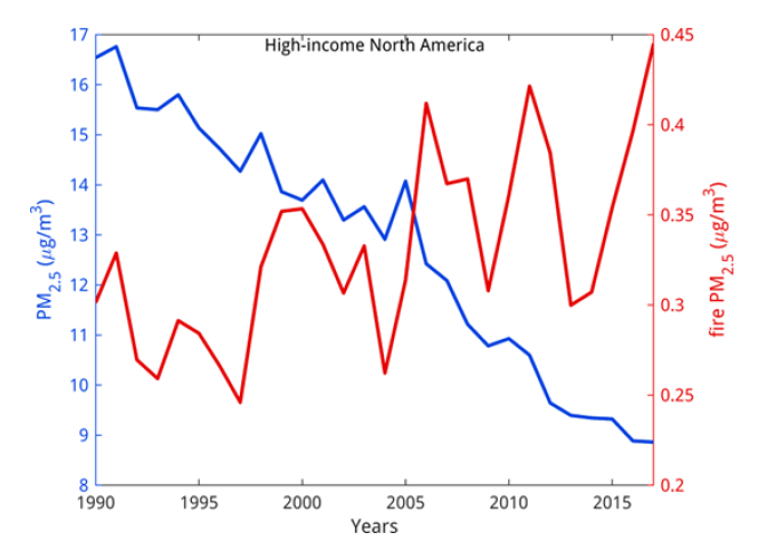Climate change is expected to promote more wildfires. Wildfires are a common source of PM2.5 emissions. Illustration: Dall-E.
In flames: Air pollution and human health
While air pollution from PM2.5-emissions have been reduced in Europe and North America, air pollution from wildfires is increasing. With climate change, we will see more wildfires, risking that the impacts of the efforts that have been made to mitigate air pollution and related negative health effects could be diminished.
What is PM2.5?
PM2.5 describes fine inhalable particles, with diameters that are generally 2.5 micrometers and smaller. Because of these particles' size, they can penetrate directly into the bloodstream, which makes them particularly dangerous to human health. PM2.5 emissions come from multiple sources, including industries, power plants, transportation, and forest fires.
The largest environmental risk factor
Air pollution is currently the largest environmental risk factor to health resulting in premature deaths globally. It causes approximately four million deaths annually, which is substantially higher compared to for example unsafe sex (around one million) and child and maternal malnutrition (around three million). PM2.5 exposure can cause a range of health issues, including respiratory and cardiovascular problems. Over the last years, PM2.5 related excess deaths have increased substantially in most of the developing countries, while having decreased in North America and Europe.
Wildfires are a source of PM2.5 emissions
Wildfires are a significant source of PM2.5 emissions, and climate change promotes more wildfires. While anthropogenic sources of PM2.5 has been decreasing over most developed countries, in part due to mitigation efforts, the importance of forest fires contribution to PM2.5 emissions have been increasing. Sourangsu Chowdhury, Senior researcher at CICERO Center for International Climate Research, explains:
Due to the use of better technologies and cleaner fuels, PM2.5 exposure from transportation, industries and power plants are declining in the developed countries of Europe and North America. However, air pollution and related health burdens from forest fires has been increasing.
This means that the efforts and progress that has been made to reduce PM2.5-emissions may be reversed due to the expected future increase in forest fires. This will have a significant impact on human health. In the HEATCOST-project researchers are quantifying health risks from heat and air pollution, with a particular focus on air pollution from wildfires.

PM2.5-exposure increased significantly in developing economies.
In sub-Saharan Africa, Latin America and other developing economies, PM2.5 exposure has increased significantly over the last years. This is in part due to forest fire related PM2.5 emissions. Even though forest burning is responsible for approximately five percent of deaths globally, new findings indicate it is an important source contributing to more than 15 percent of excess deaths in sub-Saharan Africa.
Climate change, wildfires and PM2.5
How is climate change, wildfires and PM2.5 emissions connected? The climate forest fire feedback loop is when warmer temperatures dry out the landscape and creates an environment that is more conducive towards forest fires. The wildfire seasons increase due to dryer summers, warmer springs and dryer soils and vegetation. This results in more emissions and further climate change and thus more wildfires.
This is PM2.5
PM2.5 is composed of a mixture of dust, black carbon, organic carbon, inorganic acids, salts and low volatile organic compounds. Direct release of these particles in the air is defined as primary emissions, they can be natural (for example from sea spray) or anthropogenic. Secondary particles are chemically formed in the atmosphere from precursor gases like NO2 and SO2.
